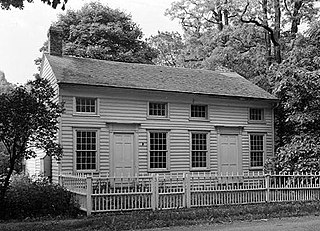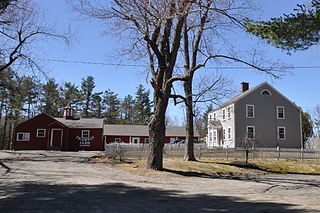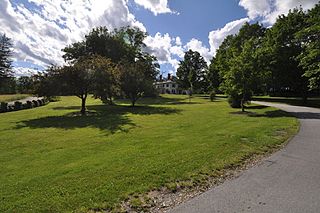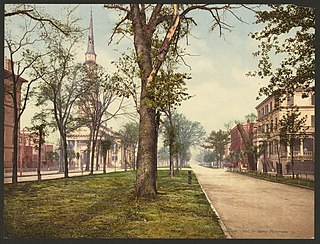
Chatham is a town in Columbia County, New York, United States. The population was 4,104 at the 2020 census, down from the 2010 census.

List of the National Register of Historic Places listings in Franklin County, New York

The Santanoni Preserve was once a private estate of approximately 13,000 acres (53 km²) in the Adirondack Mountains, and now is the property of the State of New York, at Newcomb, New York.

The Thomas Paine Cottage in New Rochelle, New York, in the United States, was the home from 1802 to 1806 of Thomas Paine, author of Common Sense, U.S. Founding Father, and Revolutionary War hero. Paine was buried near the cottage from his death in 1809 until his body was disinterred in 1819. It was one of a number of buildings located on the 300 acre farm given to Paine by the State of New York in 1784, in recognition of his services in the cause of Independence. It was here in August 1805 that he wrote his last pamphlet, which was addressed to the citizens of Philadelphia on "Constitutional Reform".

Montgomery Place, now Bard College: The Montgomery Place Campus, near Barrytown, New York, United States, is an early 19th-century estate that has been designated a National Historic Landmark. It is also a contributing property to the Hudson River Historic District, itself a National Historic Landmark. It is a Federal-style house, with expansion designed by architect Alexander Jackson Davis. It reflects the tastes of a younger, post-Revolutionary generation of wealthy landowners in the Livingston family who were beginning to be influenced by French trends in home design, moving beyond the strictly English models exemplified by Clermont Manor a short distance up the Hudson River. It is the only Hudson Valley estate house from this era that survives intact, and Davis's only surviving neoclassical country house.
This is an incomplete list of historic properties and districts at United States colleges and universities that are listed on the National Register of Historic Places (NRHP). This includes National Historic Landmarks (NHLs) and other National Register of Historic Places listings. It includes listings at current and former educational institutions.

East Hampton Village District is a historic district in East Hampton, New York.

The Cooperstown Historic District is a national historic district in Cooperstown, Otsego County, New York, that was listed on the National Register of Historic Places in 1980. It encompasses 232 contributing properties: 226 contributing buildings, 1 contributing site, 3 contributing structures, and 2 contributing objects. Among the contributing properties is the village's post office, which is individually listed on the National Register.

Old Chatham is a hamlet in the northeastern quadrant of the town of Chatham, located in Columbia County, New York, United States. It is one of the earliest settlements in the town and was originally named Chatham.
Alston-DeGraffenried Plantation or Alston-DeGraffenried House is a historic property located in Chatham County, North Carolina, near Pittsboro, North Carolina. It includes a plantation house built through the forced labor of at least 11 enslaved people between about 1810 and 1825, and its surrounding agricultural fields. The property was first listed on the National Register of Historic Places in 1974 and the listed area was increased in 1993. The house and the surrounding land are identified as a national historic district.

There are 75 properties listed on the National Register of Historic Places in Albany, New York, United States. Six are additionally designated as National Historic Landmarks (NHLs), the most of any city in the state after New York City. Another 14 are historic districts, for which 20 of the listings are also contributing properties. Two properties, both buildings, that had been listed in the past but have since been demolished have been delisted; one building that is also no longer extant remains listed.

The Centre Harbor Village Historic District encompasses the historic village of Center Harbor, New Hampshire. It consists of a small cluster of properties located north of Plymouth Street and Main Street, as well as the Nichols Memorial Library, and the Kona Fountain, which is located in the center of that intersection. It was added to the National Register of Historic Places in 1983.

Good Counsel Complex, also known as Convent of the Sisters of the Divine Compassion, is a national historic district located at White Plains, Westchester County, New York. The district consists of 10 contributing buildings, including the separately listed Mapleton. In addition to Mapleton, contributing buildings in the complex includes the convent, chapel (1897), House of Nazareth (1891), cooking school / infirmary (1901-1902), heating plant / workshop (1898), Tilford House (1856), St. Ann's Cottage (1901), and carriage house / stable (1890). The buildings include regionally significant examples of Romanesque Revival and Mediterranean Revival inspired architecture. The buildings housed the Academy of Our Lady of Good Counsel which closed in 2015 after the complex was sold. Parts of the complex were sold to Pace University School of Law in 1975. The Sisters continue to maintain a presence on the complex grounds.

The Cottage Home Historic District is a historic district and neighborhood located on the near east side of Indianapolis, Indiana. A small portion of Cottage Home is listed on the National Register of Historic Places while a larger area is listed on the state and local levels. Known for its preponderance of "cottage-style" homes built with strong Victorian influences, Cottage Home has historically been a working class neighborhood. Numerous industrial buildings are also scattered throughout the district, providing a base of economic activity. Today, however, many of these buildings are vacant, providing a special challenge to preservation and urban renewal efforts.

The Asa Morse Farm, also known as the Friendly Farm, is a historic farmstead on New Hampshire Route 101 in Dublin, New Hampshire. The main farmhouse, built in 1926 on the foundations of an early 19th-century house, is a good example of Colonial Revival architecture, built during Dublin's heyday as a summer retreat. The farmstead was listed on the National Register of Historic Places in 1983.

The Dickinson Estate Historic District encompasses the core holding of an early 20th century country estate in rural northern Brattleboro, Vermont. It includes a sophisticated Colonial Revival mansion house, built in 1900, and a variety of agricultural outbuildings dating to the same period. The estate, and in particular its barnyard complex, are well-preserved remnants of this era. The property is also notable for its association with Rudyard Kipling, who owned the estate for several years. It was listed on the National Register of Historic Places in 2005. The district covers 30 acres (12 ha) of what is now the main campus of the World Learning organization, a larger subset of the original Dickinson Estate.

The Kline Farmhouse, also known as Cold Spring Cottage, is located on a 12-acre (4.9 ha) farm along County Route 517, north of Oldwick in Tewksbury Township of Hunterdon County, New Jersey. Built by Jacob Kline in the 1790s, it was added to the National Register of Historic Places on July 11, 1984, for its significance in agriculture, architecture and settlement. Also known as the Beavers House, it was previously documented by the Historic American Buildings Survey in 1966. It was later listed as a contributing property of the Oldwick Historic District in 1988.

Oglethorpe Avenue is a prominent street in Savannah, Georgia, United States. Located, in its downtown section, between York Street to the north and Hull Street to the south, it runs for about 1.26 miles (2.03 km) from the Atlantic Coastal Highway in the west to Randolph Street in the east. It was originally known as South Broad Street, then Market Street. After being named South Broad Street again for a period, it became known as Oglethorpe Avenue in 1897. It was formerly Oglethorpe Avenue singular, but its addresses are now split between "West Oglethorpe Avenue" and "East Oglethorpe Avenue", the transition occurring at Bull Street in the center of the downtown area. The street is named for the founder of the Savannah colony, James Edward Oglethorpe.



















